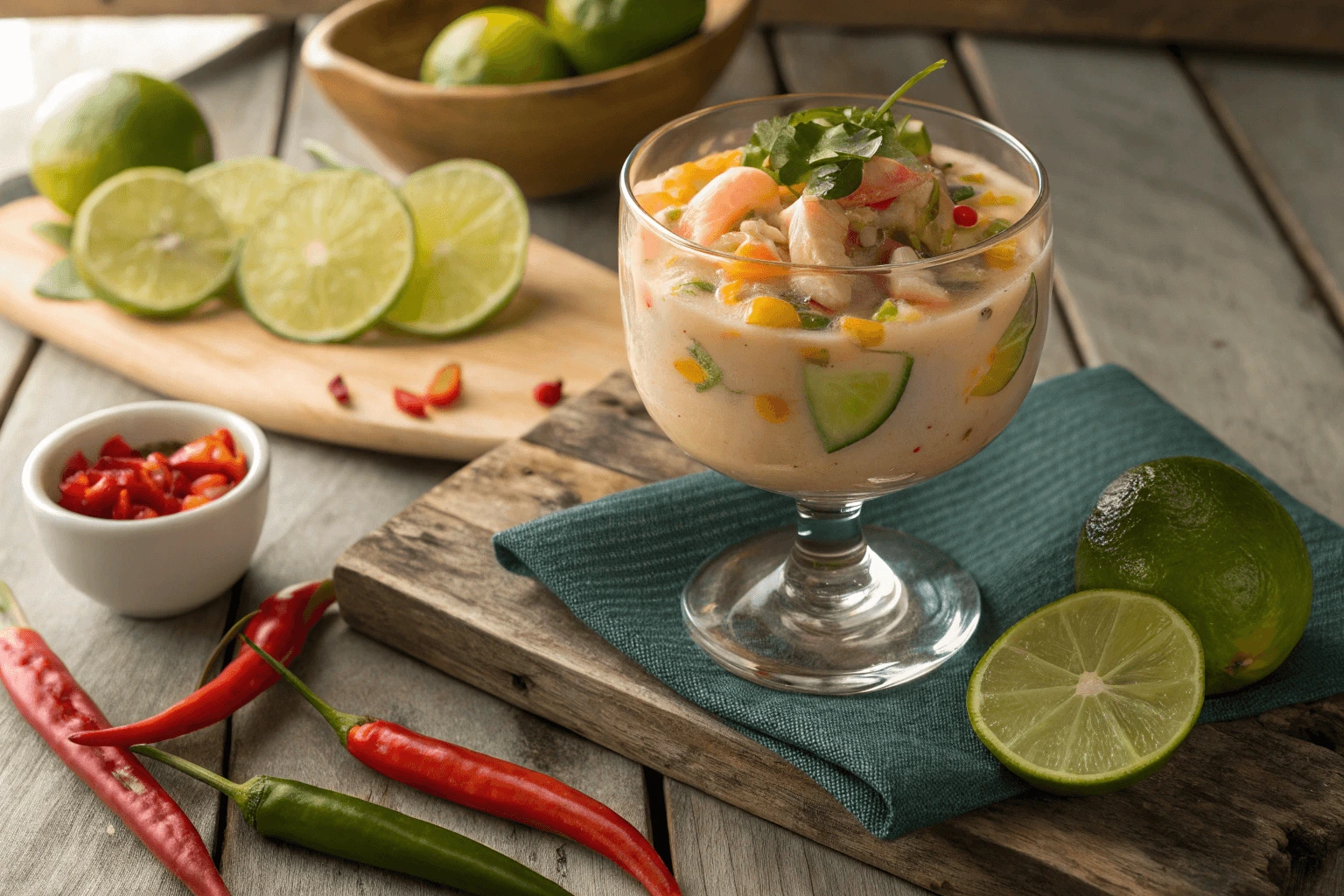Introduction
Peruvian cuisine is packed with bold flavors, but few things stand out like leche de tigre. This citrus-infused marinade, often used for ceviche, is a refreshing, tangy, and slightly spicy concoction that brings seafood to life. Some say it’s the secret behind perfect ceviche, while others swear by its supposed energy-boosting properties—hence the name, tiger’s milk.
But what is leche de tigre made of? Traditionally, it combines fresh lime juice, fish stock, garlic, onion, celery, ginger, and sometimes a kick of chili. It’s not just a marinade—it’s a dish in its own right, often served as a drink in Peru.
In this article, we’ll break down an authentic leche de tigre recipe, its variations, and how to use it beyond ceviche. You’ll also discover its health benefits, storage tips, and ideal pairings. Let’s dive into the bold flavors of Peru!
Contents
Contents
The Magic Behind Leche de Tigre
What Is Leche de Tigre, and Why Is It Special?
If you’ve ever tasted Peruvian ceviche, you’ve already encountered leche de tigre—the liquid that gives it its signature tartness and depth. But this isn’t just a marinade. It’s a staple of Peruvian street food, often enjoyed straight from a glass, sometimes with a splash of pisco (a local spirit).
So, what is tiger milk made of? Despite the name, there’s no dairy involved. It’s a blend of citrus juices, fish broth, garlic, and other seasonings that “cooks” raw seafood. The result? A vibrant, umami-packed liquid that’s both nourishing and delicious.
The Roots of This Peruvian Culinary Staple
Peru’s rich coastal waters have influenced its culinary traditions for centuries. The origins of leche de tigre trace back to pre-Columbian times when indigenous people marinated fresh fish in fermented fruits. Over time, Spanish and Asian influences refined the recipe, adding garlic, ginger, and ají peppers for extra punch.
Today, this tangy liquid is more than just a ceviche marinade—it’s a dish on its own. Many believe it’s a natural remedy for hangovers and fatigue, thanks to its sharp acidity and mineral-rich ingredients. Whether served in a shot glass or poured over fresh seafood, leche de tigre is a must-try for food lovers everywhere.
Traditional Ingredients for Authentic Flavor
Essential Components of Leche de Tigre

A great leche de tigre recipe starts with the right ingredients. This zesty liquid needs a balance of acidity, saltiness, umami, and a touch of heat. The best part? It’s made with simple, fresh ingredients that come together quickly.
So, what is leche de tigre made of? Here’s what you’ll need:
- Fresh lime juice – This is the backbone of tiger milk. It adds bright acidity, which “cooks” the fish in ceviche.
- Fish stock – A rich, well-seasoned fish broth deepens the flavor and adds complexity.
- Garlic and shallots – These provide a punchy, aromatic base.
- Celery – A small amount adds a subtle freshness and rounds out the sharp acidity.
- Ginger – This root gives leche de tigre a warm, slightly spicy kick.
- Ají amarillo paste (optional) – This yellow Peruvian chili brings heat and a slight fruitiness.
- Salt – It enhances all the flavors and brings everything together.
- Cilantro stems – These give a mild herbal note without overpowering the mix.
Fresh Lime Juice: The Key to Its Bold Taste
Lime juice does more than add tang—it’s what “cooks” raw fish in ceviche. The acidity breaks down proteins, giving the fish a firm texture without heat. But fresh lime juice is crucial; bottled versions lack the same punch and often taste artificial.
Fish Stock and Aromatics: Balancing Acidity and Depth
While some recipes skip fish stock, it adds a layer of umami that makes leche de tigre more than just lime juice and salt. When combined with garlic, shallots, and ginger, it creates a marinade bursting with depth.
Step-by-Step Guide to Making Leche de Tigre
Easy-to-Follow Preparation Method
Making leche de tigre at home is easier than you might think. The process takes just a few minutes, but the results are packed with flavor.

Here’s how to make an authentic leche de tigre recipe:
- Prep the ingredients – Juice the limes, chop the celery, peel the garlic, and gather the rest of your ingredients.
- Blend the base – In a blender, combine lime juice, fish stock, garlic, shallots, celery, ginger, and salt. Blend until smooth.
- Adjust the spice – If you like heat, add ají amarillo paste little by little, blending between additions.
- Strain (optional) – Some prefer a silky-smooth tiger milk, so you can strain the mixture through a fine sieve. Others enjoy the full-bodied texture as is.
- Chill before serving – For the best flavor, let it rest in the fridge for at least 10 minutes.
Achieving the Right Consistency and Spice Level
The perfect leche de tigre should be smooth but not watery. If it feels too thin, blending in a little extra fish stock helps. For spice lovers, more ají amarillo or even a dash of red chili can bring the heat.
Some even add a splash of pisco, a Peruvian spirit, for a little extra kick. It’s an optional twist, but one that’s loved in many cevicherías.

How to Use Leche de Tigre in Your Dishes
More Than Just a Marinade
Many people think of leche de tigre as just a marinade for ceviche, but this tangy, citrus-packed liquid has many uses. Whether you’re making seafood dishes or looking for a bold, flavorful sauce, it can be the star of your kitchen.
As a Base for Ceviche
One of the most common uses for leche de tigre is in ceviche. It “cooks” raw fish using acidity rather than heat, giving the seafood a firm texture and bright taste. But what’s the difference between ceviche and leche de tigre? While ceviche is a dish, leche de tigre is the liquid that flavors it. Some people even enjoy drinking it on the side as a shot!
As a Zesty Drink with a Spicy Kick
Yes, people actually drink leche de tigre! In Peru, it’s common to serve it in a small glass, sometimes mixed with pisco for an extra punch. Some believe it’s a natural energy booster and even a hangover cure.
Beyond ceviche, you can drizzle it over grilled seafood, use it as a dipping sauce for fried fish, or even mix it into dressings for a unique salad twist. Its bold flavor can bring any seafood dish to life.
Variations to Suit Your Taste
Regional and Modern Twists on Leche de Tigre
While the classic leche de tigre recipe sticks to traditional ingredients, different regions and chefs have put their own spin on it. Whether you want it spicier, creamier, or slightly sweet, there’s a version for everyone.
Adding Fruit for a Sweeter Touch
For those who prefer a milder taste, adding passion fruit or mango can balance the acidity of the lime juice. These fruits bring a slight sweetness without overpowering the dish.
Adjusting Spice Levels for Different Heat Preferences
If you love heat, extra ají amarillo or even red chili can take your leche de tigre up a notch. On the other hand, if you prefer a gentler taste, reducing the chili or swapping it for bell pepper can create a more subtle version.
Some modern takes even include coconut milk, making it a creamy and slightly tropical twist on the classic. Whether you stick to tradition or experiment with new flavors, leche de tigre remains a bold and refreshing addition to any seafood dish.
Health Benefits and Nutritional Insights
Why Leche de Tigre Is a Powerhouse of Nutrients
Many wonder, is leche de tigre healthy? The answer is a resounding yes! This citrus-infused marinade is packed with vitamins, minerals, and protein, making it a smart addition to any diet.
Thanks to its lime juice base, leche de tigre is rich in vitamin C, which supports the immune system and helps the body absorb iron. The fish stock adds essential minerals like potassium and magnesium, which aid muscle function and hydration. Additionally, the garlic and ginger provide anti-inflammatory benefits, while the chili peppers boost metabolism.
How It Supports Digestion and Hydration
One of the biggest benefits of leche de tigre is its digestive properties. The acidity from the lime juice helps break down food, making it easier on the stomach. This is one reason many Peruvians believe it helps with hangovers!
Moreover, because it contains fish stock, it provides hydration and replenishes electrolytes lost through sweating. Whether you’re recovering from a night out or just looking for a light, refreshing dish, this zesty marinade does the trick.
Now that we’ve covered the health perks, let’s look at some common mistakes people make when preparing leche de tigre.
Common Mistakes to Avoid
Ensuring the Perfect Balance of Flavors
A great leche de tigre recipe comes down to balance. Too much lime juice, and it can be overly sour. Not enough salt, and it tastes flat. Here are a few common pitfalls to watch out for:
- Using bottled lime juice – Always go for fresh limes. Bottled juice lacks the bright acidity needed for the perfect tiger milk.
- Skipping the fish stock – Some think lime juice alone is enough, but fish stock adds depth and rounds out the flavor.
- Adding too much chili at once – Spice builds over time, so start small and adjust as needed.
Over-Marinating and Affecting Texture
Many ask, what does ceviche do to your body? Because the acid “cooks” the fish, leaving it too long in leche de tigre can make it tough and chalky. The sweet spot is between 2 to 30 minutes—any longer, and the fish loses its delicate texture.
Best Ways to Store and Serve Leche de Tigre
Keeping Leche de Tigre Fresh
A common question is, how long can you store leche de tigre? Since it contains fresh lime juice and fish stock, it’s best enjoyed the same day. However, if you need to store it, keep it in an airtight container in the refrigerator for up to 24 hours. After that, the flavors may become too sharp, and the freshness of the fish stock will fade.
To prevent oxidation, some chefs suggest covering the surface with plastic wrap before sealing the container. This trick helps maintain the bright, fresh taste.
Ideal Serving Suggestions for Maximum Flavor
Now that your leche de tigre recipe is ready, how should you serve it? Traditionally, it’s poured over fresh ceviche, adding a bold kick of acidity and spice. But it’s also commonly enjoyed on its own, served ice-cold in a small glass.
For an extra layer of flavor, try pairing it with crispy cancha (toasted corn nuts), sweet potato slices, or fried plantains. These sides balance the sharp acidity with a touch of sweetness and crunch. If you enjoy a bit of heat, garnish with thinly sliced red chili or fresh cilantro.
Pairing Ideas for an Authentic Peruvian Feast
Dishes That Go Perfectly with Leche de Tigre
A well-made leche de tigre recipe deserves the right pairings. In Peru, it’s almost always served with ceviche, but there are plenty of other ways to enjoy it.
- Tiradito – Similar to ceviche but with thinly sliced fish and a smoother, less acidic sauce.
- Choritos a la Chalaca – Mussels topped with a fresh tomato, onion, and lime mixture.
- Jalea – A crispy, deep-fried seafood platter that pairs well with the bright acidity of leche de tigre.
Peruvian Cocktails to Complete the Experience
No Peruvian feast is complete without the right drink. Since leche de tigre is already bold and citrusy, pair it with cocktails that match its vibrant flavors:
- Pisco Sour – A classic Peruvian cocktail with pisco, lime juice, simple syrup, egg white, and bitters.
- Chilcano – A lighter option made with pisco, ginger ale, and lime.
- Chicha Morada – A non-alcoholic purple corn drink with cinnamon and cloves, perfect for balancing acidity.
Now that you have the perfect pairings, it’s time to enjoy your homemade leche de tigre! Whether you’re making ceviche or sipping it straight, this bold, zesty marinade is a must-try for seafood lovers.
Frequently Asked Questions (FAQs)
What is leche de tigre made of?
Leche de tigre is a flavorful Peruvian marinade made from fresh lime juice, fish stock, garlic, shallots, celery, ginger, cilantro stems, and salt. Some versions include ají amarillo (Peruvian chili paste) for extra heat, while others add a splash of pisco for a bold kick.
What is tiger milk made of?
Despite its name, tiger milk contains no dairy. It’s simply the English translation of leche de tigre, referring to the acidic, umami-rich liquid that gives ceviche its bold taste. The combination of citrus and fish stock creates a deeply flavorful and slightly creamy marinade.
What’s the difference between ceviche and leche de tigre?
Ceviche is a seafood dish where raw fish is marinated in lime juice until it firms up. Leche de tigre, on the other hand, is the liquid used to marinate the fish. While ceviche is served as a dish, leche de tigre is often enjoyed as a drink or poured over seafood.
Is leche de tigre healthy?
Absolutely! Leche de tigre is packed with vitamin C from lime juice, protein from fish stock, and anti-inflammatory compounds from garlic and ginger. It’s low in calories and high in essential nutrients, making it a refreshing and nutritious addition to any diet.
What does ceviche do to your body?
Ceviche provides lean protein, healthy fats, and antioxidants while being easy to digest. The high acidity aids in digestion, and the fresh ingredients support immune health. Plus, it’s naturally hydrating, making it a great option for hot weather.
How long can you store leche de tigre?
Fresh leche de tigre should be consumed within 24 hours. After that, the lime juice may become overly bitter, and the fish stock loses its freshness. Always store it in an airtight container in the fridge for the best quality.
Final Thoughts
Now that you have a complete understanding of leche de tigre, it’s time to bring this bold Peruvian marinade into your kitchen! Whether you’re using it for ceviche, sipping it as a zesty drink, or drizzling it over seafood, its refreshing taste is sure to impress.

How to Make Leche de Tigre: The Ultimate Peruvian Marinade Guide
- Total Time: 25 minutes
Description
Leche de tigre is a bold, citrusy Peruvian marinade used to “cook” raw seafood in ceviche. Made with fresh lime juice, fish stock, garlic, and ají amarillo, this zesty liquid adds depth and flavor. It can also be enjoyed as a tangy drink.
Ingredients
For the Leche de Tigre:
- 1 ¾ cups fresh lime juice
- 1 ¼ cups fish stock
- 3 cloves garlic (roasted or raw)
- 1 large or 2 small shallots
- 2 ½ teaspoons kosher salt
- 1 ½ celery ribs, chopped
- 1 tablespoon cilantro stems
- 2 tablespoons fresh ginger, grated
- 1–2 tablespoons ají amarillo paste (optional)
For Serving (Optional):
- 1 lb fresh white fish, cubed (if making ceviche)
- ½ large red onion, thinly sliced
- ¼ cup fresh cilantro leaves
- Toasted cancha (corn nuts) or sweet potato slices
Instructions
- Prepare the ingredients: Juice the limes, chop the celery, and gather all other ingredients.
- Blend the base: In a blender, combine lime juice, fish stock, garlic, shallots, celery, ginger, cilantro stems, and salt. Blend until smooth.
- Adjust the heat: If using ají amarillo paste, add it gradually and blend again.
- Strain (optional): If you prefer a smoother consistency, strain the mixture through a fine sieve.
- Chill before serving: Refrigerate for at least 10 minutes to let the flavors meld.
- Use as desired: Serve as a marinade for ceviche, a dipping sauce for seafood, or as a bold, tangy drink.
Notes
- Fresh lime juice is essential. Avoid bottled juice, as it lacks the right acidity.
- Fish stock adds depth. If unavailable, you can use clam juice as a substitute.
- Ají amarillo paste brings heat. Adjust the amount based on your spice preference.
- Storage: How long can you store leche de tigre? It’s best fresh but can be kept in an airtight container in the fridge for up to 24 hours.
- Prep Time: 10 minutes
- Cook Time: 15 minutes

